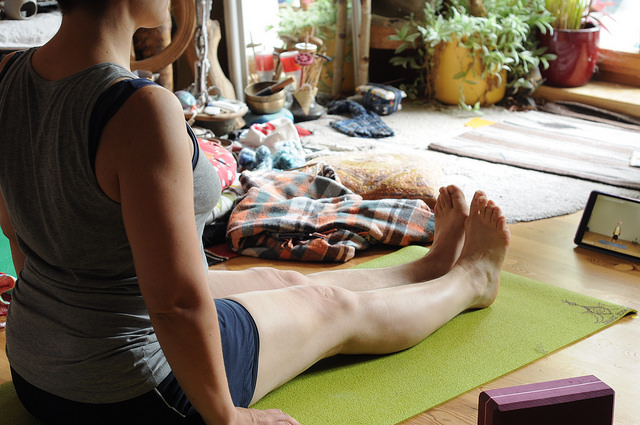I got stuck in pigeon pose.
But, let’s backtrack a bit. My journey of understanding life through yoga began at the start of 2017, when my husband and I participated, at the recommendation of my dear mentor, in a Mindfulness Based Stress Reduction (MBSR) course following Jon Kabat-Zinn’s curriculum and research, something we did for both personal and professional growth.
The secular and evidenced-based course is eight weeks in duration and teaches students the basics of mindfulness, including the attitudinal foundations of mindfulness, breath-awareness, the physiology of stress, awareness of stress reactivity, interpersonal communication, and, of course, yoga.
Yoga, as I learned, means yoke in Sanskrit, symbolizing the unification of mind and body. I said to myself, “Well the alcohol sure as hell isn’t cutting it.”
After trying Qigong in class, a specific practice of mindful movement translating to “the cultivation of life energy,” the act of mindfully following the breath through movement finally made sense. So, I joined a local yoga studio in my new home town of Philadelphia, eager to find a place to practice what I called “authentically mindful yoga.”
For a couple of years, I floated in and out of yoga, finding myself inadvertently body-shamed through the competitive and striving energy of open-level classes.
I would tell myself I was too fat and unfit for yoga, which I always considered a bougie aerobics class fused with Western hipster-cultural idealism. I saw myself with a body I was too embarrassed to show in spandex, and too ashamed to manipulate into intimate shapes with others as witness.
I felt like a live portrait of Picasso’s “The Acrobat.” Ironically, it’s this very body shame that in many ways caused me the distress I was trying to remedy with yoga—a practice which requires acute awareness of the body.
Acceptance, particularly acceptance for my changing body, is something I’m still developing. Recently, however, I developed an excitement and curiosity for what my body and mind can accomplish—the sense of control I have over myself, and the extent to which my whole body can function creatively.
I confused going through life intentionally with going through life mindfully. More specifically, I confused using my body intentionally with using my body mindfully.
Which is why I dove right into that fateful pigeon pose without the assistance of any blocks or blankets, trying to open my tight hips. I found myself head on the floor staring at my left ankle, fingers clenching the yoga mat about foot above my head, with my right foot cramping at the end of my extended leg with a locked knee, saying to myself silently, “Oh, f*ck me,” and then out loud to the class, “Help! I need an adult!”
My yoga instructor, with compassion and kindness, helped me finagle a way out of the pose, at which point I said, “I’m going to start bringing a Life Alert button to class, and by the way, we don’t even look like birds.”
I was struck with how analogous this three-minute experience was to my life, because this was not the first time in the past year that I cried “Help! I need an adult!” I was going through the flow of life without any regard for how I did so, just like the flow of this vinyasa class.
The flow continued until I became stuck in depression in the summer and fall of 2016, just as I became stuck in pigeon pose—jolting me into the awareness that I needed help to dislodge myself.
Not long ago, I was providing emotional support to a relative who, like me and many others, felt stuck. In a state of despair, she declared, “I just feel like I have a black cloud hovering over me,” to which I responded, “Well, OK. Let’s go with that. So you have this black cloud. It’s going to fade to grey, and then to white, and float away.”
Life is like the weather, patterned and cyclical, yet at times unpredictable. Life, like the weather, can be both beautiful and tragic. Life, like the weather, is not permanent.
Pema Chödrön, at the recommendation of my mindfulness-based psychotherapist, is now one of my teachers, and speaks to the certitude of change. Well, technically Pema Chödrön has no idea I exist, and I only know her through her writings, all of which I compulsively bought one night after work. Nevertheless, her teachings served as the inspiration for one of my tattoos, and she’s a household name.
In When Things Fall Apart, Pema Chödrön writes, “Impermanence is the goodness of reality. Just as the four seasons are in continual flux, winter changing to spring to summer to autumn; just as day becomes night, light becomes dark and light again—in the same way, everything is constantly evolving.”
Sweating through pigeon pose, quivering and panicking, I quickly reassured myself that I was not going to be stuck on the floor in this position forever. I trusted that the pain and discomfort I felt when I was stuck were not going to last. I knew that any discomfort I felt in my hamstrings and hips following this Olympic endeavor would heal. When I pulled out of the pose, I pulled a Tay-Tay, shook it off, and laughed about it.
We can all get stuck in life, sometimes on the floor mid-split in pigeon pose, and sometimes in other and more serious ways. And when we feel stuck—which is temporary because nothing in life is permanent—no matter the reason, there’s help for us.
We are not alone.
Namaste.
~
~
~
Author: Genevieve Gellert-Ilg
Image: Flickr
Editor: Taia Bulter











Read 1 comment and reply